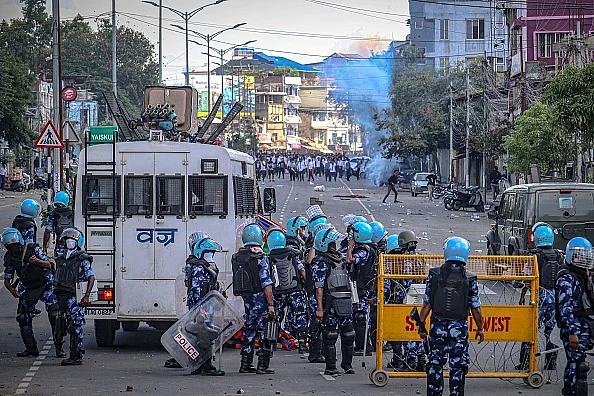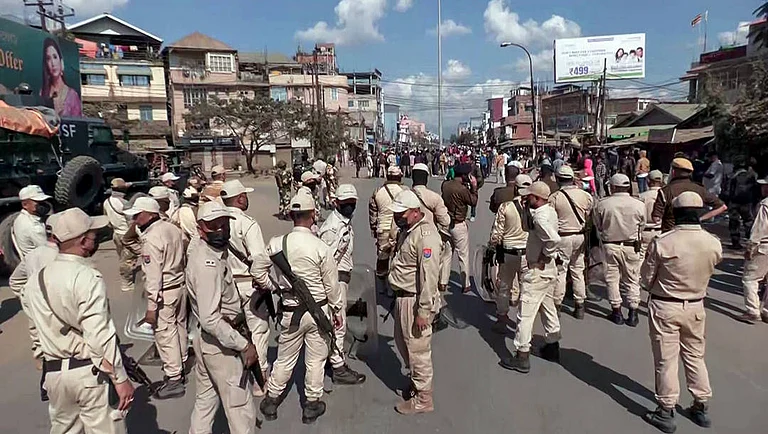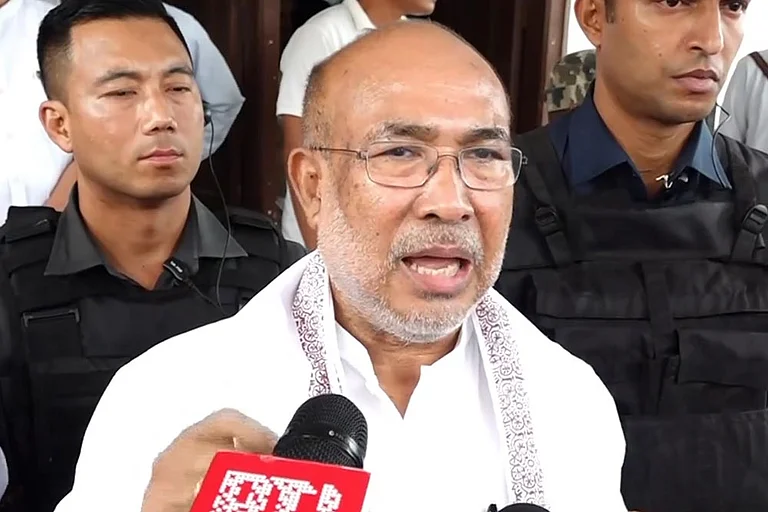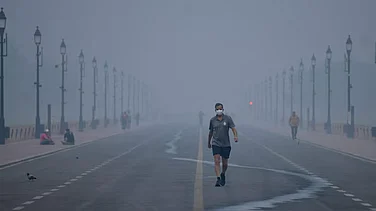A year has passed since the last time Manipur saw any resemblance of peace and harmony. The serene hill state located in India’s Northeast has been caught in a spiral of violence since May 3, 2023. As on record, more than 200 people have been killed and several hundred injured but reports from the ground indicate that the atrocities are more widespread than that. Behind the violence are claims and counter-claims over land and special benefits of two communities—Meiteis and Kuki-Zo tribes—in a state divided along religious and ethnic lines.
The Beginning
The trigger to the violence was a high court order in March last year that recommended the Meitei community, which constitutes 53 per cent of the population, to be included in the list of Scheduled Tribes (ST) in the state. The tribal groups had also raised protests about the government’s survey on reserved forests, land rights policies, eviction from villages, as well as an alleged demolition of churches in Imphal. The state cabinet had also withdrawn from the tripartite Suspension of Operations (SoO) talks with Kuki militant outfits saying they “will not compromise on steps taken to protect forest resources and for eradicating poppy cultivation.” The decision caused further damage to the already strained relations between the N Biren Singh-led BJP government and the Kukis.
The protests grew louder and a day before Biren Singh’s visit to Churachandpur on April 27, a gym he was going to inaugurate was set on fire. Curfews and internet shutdowns followed. Tensions flared further after a Tribal Solidarity March organised by the All-Tribal Students Union of Manipur (ATSUM) in which about 60,000 people are said to have participated. This gained national media attention, becoming a battleground of competing narratives and obscured truths, further deepening the rift between the Meiteis and Kuki-Zo tribes. Violence shifted from Imphal and Churachandpur to peripheral areas of Imphal valley as well, with both sides resorting to intense gunfights and ambushes.
Manipur Chief Minister N Biren Singh, under fire over his handling of the violence, almost quit a few times but kept his decision at bay under public pressure.
The 12 months of violence has severely hit businesses, schools, colleges and other institutions, besides disrupting transportation and communication networks. It also affected the agrarian sector, considered the mainstay of Manipur’s economy. The clashes may have simmered down now but sporadic incidents have been occurring in different parts of the state almost daily.
Charge Sheets on Violence
In August last year, the Central Bureau of Investigation (CBI) took over 27 cases of violence that were earlier probed by the state police. This came after one of the grimmest incidents that brought women to the centre of Manipur violence. A video went viral last July of two Kuki women who were stripped and paraded naked purportedly by a Meitei mob in a paddy field. They were allegedly gang-raped subsequently. The incident is said to have happened on May 4.
Earlier this week, the CBI released its charge sheet and the findings revealed that the women had approached a police gypsy and desperately asked the personnel to drive them to a safe location. However, they were allegedly told that "there was no key" and instead left to a mob of around 1,000 rioters in Kangpokpi district. The charge sheet also revealed that the mob had attacked a third woman, belonging to the same family, too, and tried to strip her but failed in the attempt. She managed to escape after the group went towards the first two victims.
The CBI has also filed two separate charge sheets against five accused in connection with the case of two missing Manipuri students who were feared killed during the ethnic violence, although an investigation is still underway. Photos purportedly showing their bodies surfaced in September leading to violent protests, mainly by students.
In January, the CBI also filed a charge sheet against five people for looting of arms and ammunition from Manipur Police. They had earlier been arrested by the Manipur Police when they were allegedly extorting money by wearing police uniforms and carrying sophisticated weapons. The arrests had sparked off a two-day-long protest.
Attempts to Restrict Press Freedom
Manipur has been under an information blockade since May 2023. This has not only restricted the freedom of expression of the residents, especially the minority tribes, but also attempted to clamp down on essential journalistic freedoms of media and news professionals.
Many journalists who went to cover the violence have been attacked, some of which came to light. In May, three journalists were reportedly physically assaulted by security forces while covering the burning of a church in New Checkon in Imphal. In another incident, a reporter from Aaj Tak was reportedly manhandled by a BJP worker in the Directorate of Information and Public Relations office in Imphal.
In September, the BJP-controlled state police filed criminal charges against four journalists—a fact-finding team of the Editors Guild of India—accusing them of misrepresenting information in a report about the clashes between ethnic groups. On December 31, the police arrested Wangkhemcha Shyamjai, the editor of the vernacular daily Kangleipaki Meira, for allegedly publishing “provocative news”.
Where the Situation Stands
The year-long communal strife has upturned the political fabric of Manipur with growing intercommunity distrust, unrest, and division.
Even amid Lok Sabha elections, there has been no enthusiasm in Manipur. The state has traditionally seen a very high voter turnout with more than 82 per cent polling recorded in the 2019 elections. But the ethnic violence has cast a shadow on the polls this time with civil society groups and the affected people questioning the relevance of polls in the current circumstances. While the Kukis and Meitis are still at loggerheads, their thoughts on one point converged that this is not the right time for Lok Sabha elections in the restive state.
The conflict-hit state recorded a 68 per cent turnout, one of the lowest in the first phase of polls, amid incidents of firing, intimidation, destruction of EVMs and allegations of booth capturing. Meanwhile, the Election Commission of India has ordered re-polling in six booths of the Outer Manipur constituency that voted in the second phase on Friday amid reports of voter intimidation and EVM destruction.




























